Posted June 15, 2021 by Nicky in Reviews / 2 Comments
 White Bread, Aaron Bobrow-Strain
White Bread, Aaron Bobrow-Strain
I wasn’t sure how interesting a book on store-bought white bread could be, but someone recommended it to me and I wanted to give it a chance… and it was everything I could want from the kind of book which takes an everyday part of life and digs into its history and social meaning. Bobrow-Strain lays bare all kinds of things about the US which you wouldn’t necessarily link to white bread. Or maybe, knowing the US you would — wealth, health, religion, race.
It ended up being really fascinating: rather densely written — for 200 pages, it took me a while — but in a good way, informative and considerate. Unlike another recent book on food I read, Reinventing the Wheel, it managed not to sound like it was judging everyone in the world’s bad food choices for causing problems. Instead it really dug into why white bread seemed (and seems) so desirable, and what powerful motivations lie behind the choice.
I’d really love to know more about this whole subject as relates to the UK as well, and I’m eager to explore the references for more books on food, since I’ve been finding them fascinating lately.
Rating: 5/5
Tags: Aaron Bobrow-Strain, book reviews, books, history, non-fiction
Posted March 29, 2021 by Nicky in Reviews / 1 Comment
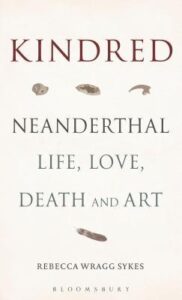 Kindred: Neanderthal Life, Love, Death and Art, Rebecca Wragg Sykes
Kindred: Neanderthal Life, Love, Death and Art, Rebecca Wragg Sykes
That’s a pretty big title, particularly as it includes concepts that people doubt applied to Neanderthals (like love and art). Nonetheless, Wragg Sykes lives up to it, painting a picture of the current state of the art in understanding Neanderthals, their lives, their relationships to each other… and their relationships to us. I lost count of the number of times I just had to share a snippet or an image from this book with my wife, because it’s just so cool what we can know about these people, from the way they ate to their technology level.
One example: their technology level, since we’re speaking of that, was higher than you’d think — for example, they were creating a sort of glue from resin. Pine resin was the best, but other resin when mixed with beeswax gained similar properties, and they knew that and used it! There are multiple levels of technology there, from getting the resin out of the bark (which required a low-oxygen fire) to mixing it to applying it to attaching spearheads to hafts, etc.
I knew some of the things mentioned in this book, of course, particularly when it comes to how Neanderthals are related to us. But much of it was new, or more detailed than I thought, and Wragg Sykes’ interpretation of the evidence is fascinating. Even if you don’t go all the way with her in attributing complex thought and planning to Neanderthals (though I think the evidence tends in her direction), the evidence is astounding enough to keep your attention.
This is actually that rarest of things: a popular science book which I will keep, even though I probably won’t read it again, because I enjoyed it so much and I would like to have it to hand to refer to in the future.
Rating: 5/5
Tags: book reviews, books, history, non-fiction, Rebecca Wragg Sykes, science
Posted March 21, 2021 by Nicky in Reviews / 0 Comments
 The Restaurant: A History of Eating Out, William Sitwell
The Restaurant: A History of Eating Out, William Sitwell
Perhaps unsurprisingly, this survey of eating out through the ages covers Britain most heavily, especially toward the end of the book. Which somewhat makes sense as a strategy, given the scope of the theme “eating out”, but the subtitle doesn’t really make that clear. In the end, I don’t know a lot about food, so I can’t say much about the accuracy of the actual information, but Sitwell writes clearly (if not always with sparkling prose) and introduces the important points well, developing his theme about the fact that British food isn’t really that bad after all, and that we have our own food-wizards.
Like I said, though, it’s not always sparkling prose, and I did drift off a bit. It’s actually a nice source for a story I want to write, so it served its purpose, but… to put it another way, it’s not the kind of non-fiction where I turned to my wife to ask “did you know? did you know?” — nor the kind of non-fiction I read compulsively, eagerly, regardless of the topic. (And there are certainly books that fascinate me about topics that don’t; Richard Fortey can make me enthused about geology, for goodness’ sake.)
So, interesting, but not special, I guess would be my summary.
Rating: 3/5
Tags: book reviews, books, history, non-fiction, William Sitwell
Posted February 28, 2021 by Nicky in Reviews / 0 Comments
 The Pocket: A Hidden History of Women’s Lives, Barbara Burman, Ariane Fennetaux
The Pocket: A Hidden History of Women’s Lives, Barbara Burman, Ariane Fennetaux
Focusing on 1660 to 1900 (a very precise time range!), this book uses the tie-on pocket as an ‘in’ to dig into women’s lives via the historical records, including the physical records (pockets which have ended up in collections and museums), writing and court records. It’s a fairly academic book — lots of “meaning resides in the blahblahblah” type language — and also serves as a pretty comprehensive repository for photographs of extant pockets and their details, but it’s accessible enough if you have enough of an interest, and there’s a lot of fascinating detail.
What really surprised me was how long the tie-on pocket lasted, and the wealth of evidence the authors were actually able to show about how they were used, made, obtained, bought, bartered, pawned and gifted. They really do make a good entrée for the history of women’s lives; I thought one of the most interesting parts were the court records, giving us a glimpse into what women carried in their pockets and why.
Not the most riveting read, even for non-fiction, but the photographs are beautifully done and in full colour, and the subject is fascinating enough that I found it well worth the slightly dry and academic approach.
Rating: 3/5
Tags: book reviews, books, history, non-fiction
Posted February 28, 2021 by Nicky in Reviews / 0 Comments
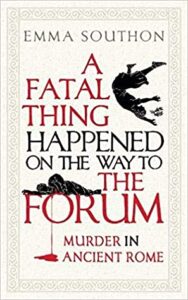 A Fatal Thing Happened on the Way to the Forum, Emma Southon
A Fatal Thing Happened on the Way to the Forum, Emma Southon
I worried from the title and first few pages that this might prove too flippant and shallow from me, but I was wrong to worry. I quickly settled into it, and it’s obvious that Southon knows her stuff, takes deep joy in it, and knows where she can skimp on explanations a bit in order to get to the meat of things. She gives a lot of context without getting too bogged down in it, while telegraphing that the point is coming; if you really hate comments like “bear with me, we’re getting to the good stuff”, then it won’t work for you… but mostly, I thought she did a really good job.
The idea of a book about murder in Rome gave me a bit of pause, since I didn’t think they really had such a concept… and indeed, I was right, and Southon acknowledges that it’s a very modern way to interrogate these sources, and that in many of the cases described, no one batted an eyelid (the murder of slaves, particularly). As she says, though, the deaths and the attitudes to those deaths still tell us a lot about Roman society and the place of various people within it.
I was intrigued by the topic, but didn’t expect to find it a pageturner; that it was says something about how engaging Southon’s writing was. I found it deeply enjoyable — particularly as it was one of those books that had me turning to my wife to delightedly ask ‘did you know?’ and read bits out or wave my hands excitedly as I connected up bits and shared the fun.
Rating: 5/5
Tags: book reviews, books, Emma Southon, history, non-fiction
Posted February 27, 2021 by Nicky in Reviews / 2 Comments
 A Cheesemonger’s History of the British Isles, Ned Palmer
A Cheesemonger’s History of the British Isles, Ned Palmer
This one is exactly what it says on the tin: a history of the British Isles which follows the lot of cheese, cheesemakers, affineurs and cheesemongers. It touches on a surprising amount of history, getting further into things that you might expect. Armies march on their stomachs, which are partly full of cheese, for a start.
It isn’t, of course, just pure history: there’s also a lot of speculation, from what ancient cheeses might have tasted like to who might have made them and why, and I wouldn’t exactly cite it as a source for something because it’s chatty and speculative, using experience to pry into parts of history we just can’t see. For example, he mentions at one point that the monks in a monastery can’t have been the ones to make the cheese, because they couldn’t leave the grounds and the herds would have been elsewhere… and you need to start the process right away. He speculates that they probably acted as affineurs, aging and storing the cheeses once made.
I don’t always love history when it’s speculative, but Palmer’s expertise about cheese is obvious — and he gets onto more solid ground with sources to refer to as well, with the later parts of the book. I love eating cheese, but it’s obvious I need to try more different kinds of cheese… and I had no idea of most of the details of how cheese is made, how different cheeses are ripened and different effects are produced. Palmer’s enthusiasm makes all of that interesting, and his book is riveting.
Rating: 5/5
Tags: book reviews, books, history, Ned Palmer, non-fiction
Posted February 24, 2021 by Nicky in Reviews / 0 Comments
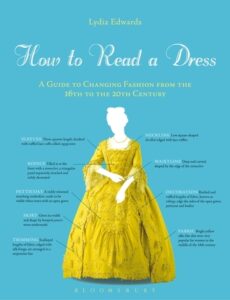 How To Read A Dress, Lydia Edwards
How To Read A Dress, Lydia Edwards
This book is a handy survey of women’s fashion (mostly of dresses, but occasionally including titbits about other aspects of dress and accessorising, like necklaces and shoes) from the 16th to the 20th century. It features full-colour photographs, carefully annotated with useful pointers as to what to notice, and introductory essays explaining the trends of each period.
The annotation is very good, but the introductory paragraphs for each section are a bit less organised. It doesn’t refer to specific examples of dresses in that chapter, but stays totally general… meaning it’s hard for me — a not especially visual person — to link the dresses up with the trends they illustrate. Sometimes I’d look through the dresses for a specific feature, but not really see anything that seemed to match. In addition, sometimes the text would mention a specific photograph or illustration, but it wasn’t next to the text, and there was no helpful “(figure 3)” or anything; instead it would say something like “this photograph of a gentleman…” Which photograph of a gentleman? What page it is on?!
Anyway, I found it really interesting, and useful, with a few flaws. It would probably work better for someone with a visual memory!
Rating: 3/5
Tags: book reviews, books, history, Lydia Edwards, non-fiction
Posted February 7, 2021 by Nicky in Reviews / 0 Comments
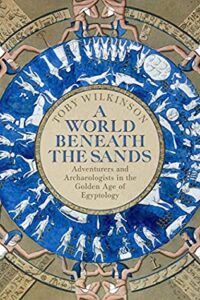 A World Beneath the Sands, Toby Wilkinson
A World Beneath the Sands, Toby Wilkinson
A World Beneath the Sands is a book not about Egyptology, for the most part, but about Egyptologists — and not just the highlights (Champollion, Petrie, Howard Carter) but some of the less-known names as well, including some of the women who facilitated the study of Ancient Egypt. Broadly speaking, it should have been my thing, but in execution, it just… wasn’t. It was rather slow, and just… not very exciting.
It was mostly about political manoeuvring and the various European countries that jockeyed over control of Egypt, and the doing of archaeology a distant second. The details of digs and finds were barely described, mostly just listed off before moving onto the next list of finds.
In principle, a history of the archaeologists, scholars and looters who shaped our understanding of the history of Ancient Egypt really should have been fascinating, but I found it really dry and unnecessarily verbose. I’m hoping it’s just because I didn’t enjoy the topic as much as expected, because I have another of Wilkinson’s books (The Rise and Fall of Ancient Egypt), and I’m hoping to enjoy that a lot!
Rating: 2/5
Tags: book reviews, books, history, non-fiction, Toby Wilkinson
Posted February 7, 2021 by Nicky in Reviews / 0 Comments
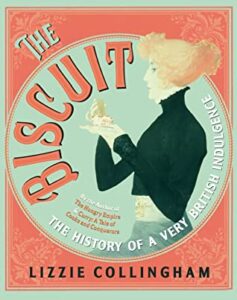 The Biscuit: The History of a Very British Indulgence, Lizzie Collingham
The Biscuit: The History of a Very British Indulgence, Lizzie Collingham
When I mention that I’ve been reading a history of biscuits, people’s usual response is confusion about why that would take a whole book or be particularly interesting. The answer is that Collingham discusses the social, economic and political circumstances surrounding the development of biscuits, and though the subtitle calls it a “British indulgence“, it discusses other countries too and the colonial uses of biscuits (yes, really — they were thought to be useful in ‘civilising’ places like India).
This was exactly what I was hoping for: a microhistory on a really narrow topic that used that topic to reflect on larger issues. You might not automatically think of looking at the Industrial Revolution through the role of biscuits, or realise the extent to which naval voyages of exploration relied on ship’s biscuit, or appreciate the fact that the original biscuits were twice-baked bread made a couple of times a year in communities that couldn’t afford to bake fresh bread every day… but all those different topics can open out when you start digging in.
You don’t just get to learn about when they started making Jammie Dodgers, or that the company was notoriously cheapskate and used plums for the “raspberry” jam in them because it was cheaper than raspberries… that’s certainly one of the things I learned, but I also learned that the custom of following savoury food with a sweet dessert has come down in a very long tradition from when the stomach was thought to putrefy food, and Arab ideas that sugar was ideal to help seal off the stomach from harmful vapours caused by that process.
In the end, it’s a history of biscuits and it comes back to that pretty swiftly when it strays away, but using the biscuit as a home base, it can tell you an awful lot.
In addition, it also contains some recipes between chapters, some of them traditional and others from modern sources. I haven’t tried any, since I’m not the baker of the family and I’m also very lazy, but it’s a nice touch and we’ll probably keep my copy in order to give them a try someday.
Rating: 4/5
Tags: book reviews, books, history, Lizzie Collingham, non-fiction
Posted February 4, 2021 by Nicky in Reviews / 0 Comments
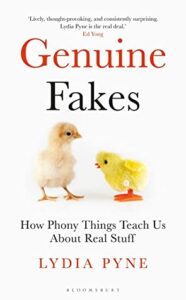 Genuine Fakes: How Phony Things Teach Us About Real Stuff, Lynda Pyne
Genuine Fakes: How Phony Things Teach Us About Real Stuff, Lynda Pyne
I didn’t really expect this book to be so riveting, but it really was. The central idea is a bit shaky, because Lynda Pyne’s definition of “genuine fakes” is very, very elastic: one example is lab-created diamonds, another is the Spanish Forger’s faked medieval illustrations, another is the faked Archaeoraptor fossil… The things that make each item “genuine” or “fake” are pretty flexible. The reasoning is most solid when it comes to art like the Spanish Forger’s work, which has now become desirable in and of itself. The reasoning for the Archaeoraptor fossil is basically “well, it’s made up of real fossils!” Yeah, who cares, those fossils have been ripped from their original correct context in a desperate attempt to deceive people and get more money. That’s not a genuine fake, that’s just a fake.
And then there’s a bit about wildlife documentaries and how they’re kind of fake (sometimes, depending on how they’re filmed) and kind of not, and the point kind of dissipated somewhere in there for a while in favour of just explaining how much money it takes to create a documentary like Blue Planet II.
That all said, though, even if Pyne’s examples don’t all hang together, I enjoyed her dissection of each item and the things it has to tell us. I didn’t know anything about the Spanish Forger before, and that was maybe my favourite thing to learn about. Interesting stuff here, just… not really very organised.
Rating: 3/5
Tags: book reviews, books, history, Lynda Pyne, non-fiction, science
 White Bread, Aaron Bobrow-Strain
White Bread, Aaron Bobrow-Strain








